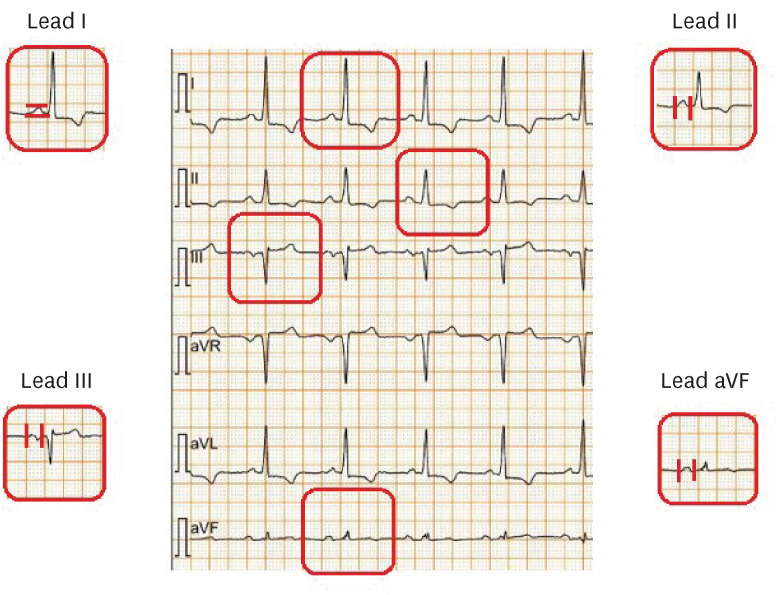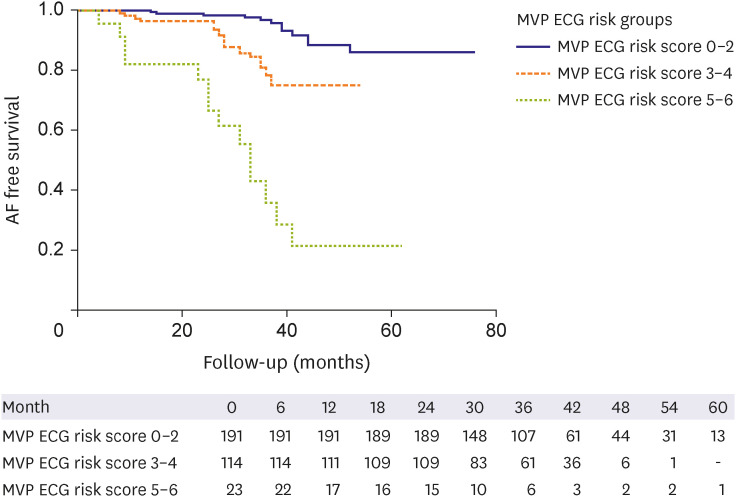Korean Circ J.
2023 Sep;53(9):621-631. 10.4070/kcj.2022.0353.
Efficiency of MVP ECG Risk Score for Prediction of Long-Term Atrial Fibrillation in Patients With ICD for Heart Failure With Reduced Ejection Fraction
- Affiliations
-
- 1Department of Cardiac, Ardahan State Hospital, Ardahan, Turkey
- 2Department of Cardiology, Dr Siyami Ersek Thoracic and Cardiovascular Surgery Training Hospital, İstanbul, Turkey
- 3Department of Cardiac Electrophysiology, Başakşehir Çam ve Sakura City Hospital, Istanbul, Turkey
- KMID: 2545956
- DOI: http://doi.org/10.4070/kcj.2022.0353
Abstract
- Background and Objectives
The morphology-voltage-P-wave duration (MVP) electrocardiography (ECG) risk score is a newly defined scoring system that has recently been used for atrial fibrillation (AF) prediction. The aim of this study was to evaluate the ability of the MVP ECG risk score to predict AF in patients with an implantable cardioverter defibrillator (ICD) and heart failure with reduced ejection fraction in long-term follow-up.
Methods
The study used a single-center, and retrospective design. The study included 328 patients who underwent ICD implantation in our hospital between January 2010 and April 2021, diagnosed with heart failure. The patients were divided into low, intermediate and high-risk categories according to the MVP ECG risk scores. The long-term development of atrial fibrillation was compared among these 3 groups.
Results
The low-risk group included 191 patients, the intermediate-risk group 114 patients, and the high-risk group 23 patients. The long-term AF development rate was 12.0% in the low-risk group, 21.9% in the intermediate risk group, and 78.3% in the high-risk group. Patients in the high-risk group were found to have 5.2 times higher rates of long-term AF occurrence compared to low-risk group.
Conclusions
The MVP ECG risk score, which is an inexpensive, simple and easily accessible tool, was found to be a significant predictor of the development of AF in the long-term follow-up of patients with an ICD with heart failure with reduced ejection fraction. This risk score may be used to identify patients who require close follow-up for development and management of AF.
Figure
Cited by 1 articles
-
Can Current Subclinical Atrial Fibrillation Be Verified by P Wave of 12-Lead ECG at Present? The Answer Already Exists in the Atrial Substrate
Seung Yong Shin
Korean Circ J. 2023;53(9):632-634. doi: 10.4070/kcj.2023.0188.
Reference
-
1. Mirowski M, Reid PR, Mower MM, et al. Termination of malignant ventricular arrhythmias with an implanted automatic defibrillator in human beings. N Engl J Med. 1980; 303:322–324. PMID: 6991948.
Article2. Proietti R, Labos C, Davis M, et al. A systematic review and meta-analysis of the association between implantable cardioverter-defibrillator shocks and long-term mortality. Can J Cardiol. 2015; 31:270–277. PMID: 25746019.
Article3. Mittal S, Movsowitz C, Steinberg JS. Ambulatory external electrocardiographic monitoring: focus on atrial fibrillation. J Am Coll Cardiol. 2011; 58:1741–1749. PMID: 21996384.4. Mendieta G, Guasch E, Weir D, et al. Advanced interatrial block: a predictor of covert atrial fibrillation in embolic stroke of undetermined source. J Electrocardiol. 2020; 58:113–118. PMID: 31816563.
Article5. Martínez-Sellés M, Elosua R, Ibarrola M, et al. Advanced interatrial block and P-wave duration are associated with atrial fibrillation and stroke in older adults with heart disease: the BAYES registry. Europace. 2020; 22:1001–1008. PMID: 32449904.6. Alexander B, Haseeb S, van Rooy H, et al. Reduced P-wave voltage in lead I is associated with development of atrial fibrillation in patients with coronary artery disease. J Atr Fibrillation. 2017; 10:1657. PMID: 29487682.7. Alexander B, Milden J, Hazim B, et al. New electrocardiographic score for the prediction of atrial fibrillation: the MVP ECG risk score (morphology-voltage-P-wave duration). Ann Noninvasive Electrocardiol. 2019; 24:e12669. PMID: 31184409.
Article8. McManus DD, Hsu G, Sung SH, et al. Atrial fibrillation and outcomes in heart failure with preserved versus reduced left ventricular ejection fraction. J Am Heart Assoc. 2013; 2:e005694. PMID: 23525446.9. Sakhuja R, Shah AJ, Keebler M, Thakur RK. Atrial fibrillation in patients with implantable defibrillators. Cardiol Clin. 2009; 27:151–161. PMID: 19111771.10. McDonagh TA, Metra M, Adamo M, et al. 2021 ESC Guidelines for the diagnosis and treatment of acute and chronic heart failure. Eur Heart J. 2021; 42:3599–3726. PMID: 34447992.
Article11. Kizilirmak F, Demir GG, Gokdeniz T, et al. Changes in electrocardiographic P wave parameters after cryoballoon ablation and their association with atrial fibrillation recurrence. Ann Noninvasive Electrocardiol. 2016; 21:580–587. PMID: 27018476.
Article12. Hindricks G, Potpara T, Dagres N, et al. 2020 ESC Guidelines for the diagnosis and management of atrial fibrillation developed in collaboration with the European Association for Cardio-Thoracic Surgery (EACTS): the Task Force for the diagnosis and management of atrial fibrillation of the European Society of Cardiology (ESC) Developed with the special contribution of the European Heart Rhythm Association (EHRA) of the ESC. Eur Heart J. 2021; 42:373–498. PMID: 32860505.13. Michniewicz E, Mlodawska E, Lopatowska P, Tomaszuk-Kazberuk A, Malyszko J. Patients with atrial fibrillation and coronary artery disease - double trouble. Adv Med Sci. 2018; 63:30–35. PMID: 28818746.
Article14. Mogensen UM, Jhund PS, Abraham WT, et al. Type of atrial fibrillation and outcomes in patients with heart failure and reduced ejection fraction. J Am Coll Cardiol. 2017; 70:2490–2500. PMID: 29145948.
Article15. Pistoia F, Sacco S, Tiseo C, Degan D, Ornello R, Carolei A. The Epidemiology of atrial fibrillation and stroke. Cardiol Clin. 2016; 34:255–268. PMID: 27150174.
Article16. Wang A, Green JB, Halperin JL, Piccini JP Sr. Atrial fibrillation and diabetes mellitus: JACC review topic of the week. J Am Coll Cardiol. 2019; 74:1107–1115. PMID: 31439220.17. Verdecchia P, Angeli F, Reboldi G. Hypertension and atrial fibrillation: doubts and certainties from basic and clinical studies. Circ Res. 2018; 122:352–368. PMID: 29348255.18. Blomström-Lundqvist C, Traykov V, Erba PA, et al. European Heart Rhythm Association (EHRA) international consensus document on how to prevent, diagnose, and treat cardiac implantable electronic device infections-endorsed by the Heart Rhythm Society (HRS), the Asia Pacific Heart Rhythm Society (APHRS), the Latin American Heart Rhythm Society (LAHRS), International Society for Cardiovascular Infectious Diseases (ISCVID) and the European Society of Clinical Microbiology and Infectious Diseases (ESCMID) in collaboration with the European Association for Cardio-Thoracic Surgery (EACTS). Europace. 2020; 22:515–549. PMID: 31702000.
Article19. Marrouche NF, Brachmann J, Andresen D, et al. Catheter ablation for atrial fibrillation with heart failure. N Engl J Med. 2018; 378:417–427. PMID: 29385358.
Article20. Daubert JP, Zareba W, Cannom DS, et al. Inappropriate implantable cardioverter-defibrillator shocks in MADIT II: frequency, mechanisms, predictors, and survival impact. J Am Coll Cardiol. 2008; 51:1357–1365. PMID: 18387436.21. Poole JE, Johnson GW, Hellkamp AS, et al. Prognostic importance of defibrillator shocks in patients with heart failure. N Engl J Med. 2008; 359:1009–1017. PMID: 18768944.
Article22. Klein RC, Raitt MH, Wilkoff BL, et al. Analysis of implantable cardioverter defibrillator therapy in the Antiarrhythmics Versus Implantable Defibrillators (AVID) trial. J Cardiovasc Electrophysiol. 2003; 14:940–948. PMID: 12950538.
Article
- Full Text Links
- Actions
-
Cited
- CITED
-
- Close
- Share
- Similar articles
-
- Heart Failure With Preserved Ejection Fraction and Atrial Fibrillation: Are Beta-Blockers Still Relevant?
- Sudden cardiac death in heart failure with preserved ejection fraction: an updated review
- Non-medication Treatment of Atrial Fibrillation
- Pathophysiology and Diagnosis in Atrial Fibrillation
- Beta Blockers in Contemporary Cardiology: Is It Better to Cast Them Out?




